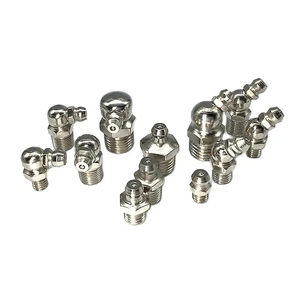
All categories
Featured selections
Trade Assurance
Buyer Central
Help Center
Get the app
Become a supplier

(807 products available)






































An angle grease nipple, also known as an angled grease fitting, is a mechanical component used to receive the lubricating grease supplied to the internal bearings or to the internal mechanism of a machine using a grease gun. The grease gun delivers the grease under pressure, and the fitting allows the grease to flow inside while preventing the entry of foreign materials like dust and water into the bearing or internal mechanism. Grease fittings are designed to make the process of lubricating machinery with grease easier and more convenient, ensuring proper lubrication and reducing the risk of contamination. The angle grease fitting is preferable in areas with limited space for the conventional straight grease fitting to protrude.
Angle grease fittings are available in a variety of types, including:
Regular cleaning
It is important to ensure that the surfaces around the grease fittings are wiped clean. This prevents contaminants from entering the fittings and potentially causing blockages or damage.
Inspect for damage
Users should regularly check their angled grease fittings for any signs of wear and tear or damage. In case there is any damage, timely replacement of the fittings will help to maintain proper lubrication.
Check for smooth operation
Users should regularly check their angled grease fittings for any signs of wear and tear or damage. In case there is any damage, timely replacement of the fittings will help to maintain proper lubrication.
Use the right grease
It is important to use a high-quality grease that is suitable for the specific application. Also, using the wrong type of grease can cause performance issues and potentially damage the fittings.
Prevent overfilling
When using a grease gun on angle fittings, users should be careful not to overfill the grease cavity. This can lead to excess grease being forced into surrounding components, which may result in a mess and potential interference with their function.
Protect from corrosion
Angle grease fittings should be kept dry and, if necessary, coated with protective agents to prevent rust and corrosion. This will ensure the longevity of the fittings and their optimal performance.
Follow manufacturer's recommendations
Users should adhere to the maintenance schedule and lubrication instructions provided by the manufacturer for the specific equipment or vehicle utilizing grease fittings. This will ensure that the angle grease fittings are maintained in the right conditions and according to the specifications, thereby enhancing their functionality.
Here are some tips for choosing the right angle grease fittings for a particular application:
Compatibility
Selecting the right grease type as well as the right fitting is important.
Consider the compatibility of the angle fittings with the existing lubrication system.
Quality and durability
Quality and durable angle grease nipples are essential for reliability.
Consider the material and manufacturing process of the angle grease fittings.
Application requirements
Identifying the application requirements is essential in selecting the right angle grease fittings.
Consider the size of the angle fittings, the coupling style as well as the thread size.
Maintenance and availability
Selecting angle grease fittings that are easy to maintain is essential for reliability.
Consider the availability of the selected angle fittings and their accessories.
Sealing and protection
Consider the angle grease fittings with seals and protective covers.
Cost-effectiveness
Cost-effectiveness is considered when selecting the angle grease fittings.
Replacing an angle grease fitting is an easy DIY task that can be accomplished in a few steps. Here is a step-by-step guide on how to replace an angle grease nipple:
Tools and materials needed:
Step-by-step guide:
Q1. How often should joints with angles grease nipples be lubricated?
A1. The frequency of lubrication depends on several factors, such as joint movement, environmental conditions, and grease type. However, a general guideline is to grease the joints every 1-3 months or after every 50-100 hours of equipment use.
Q2. What type of grease is suitable for angle grease nipples?
A2. While there are many types of greases suitable for angle grease nipples, the most common is lithium-based grease. This grease is waterproof and has a high melting point, making it ideal for use in various applications. However, it is advisable to check the manufacturer's recommendations before settling on a type of grease.
Q3. Can one use an electric greaser on angle grease nipples?
A3. Yes, one can use an electric greaser on angle grease nipples. In fact, using an electric greaser is more efficient than using a manual one, especially when dealing with numerous or hard-to-reach grease fittings. The electric greaser also ensures a consistent and accurate grease application.
Q4. Are all angles grease nipples the same?
A4. No, not all angle grease nipples are the same. There are different types, sizes, and materials, each suited for specific applications. While they may have similar functions, angle grease fittings vary in design and performance.
Q5. Can one clean grease nipples using a wire brush?
A5. While it is possible to clean grease nipples using a wire brush, it is not recommended. A wire brush can damage the nipple's surface, leading to leaks and contamination. It is advisable to use a lint-free cloth or a specialized grease nipple cleaning tool.